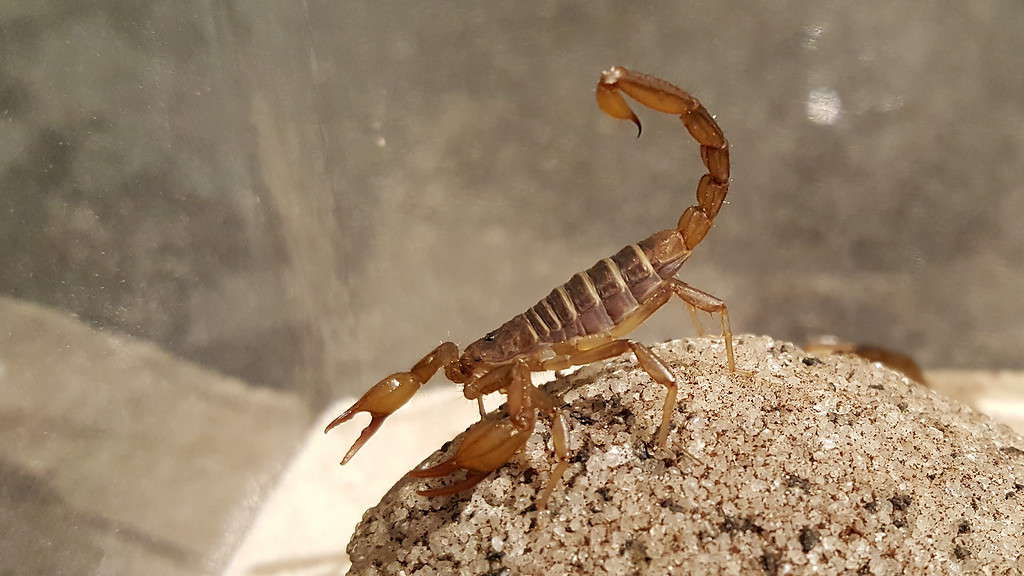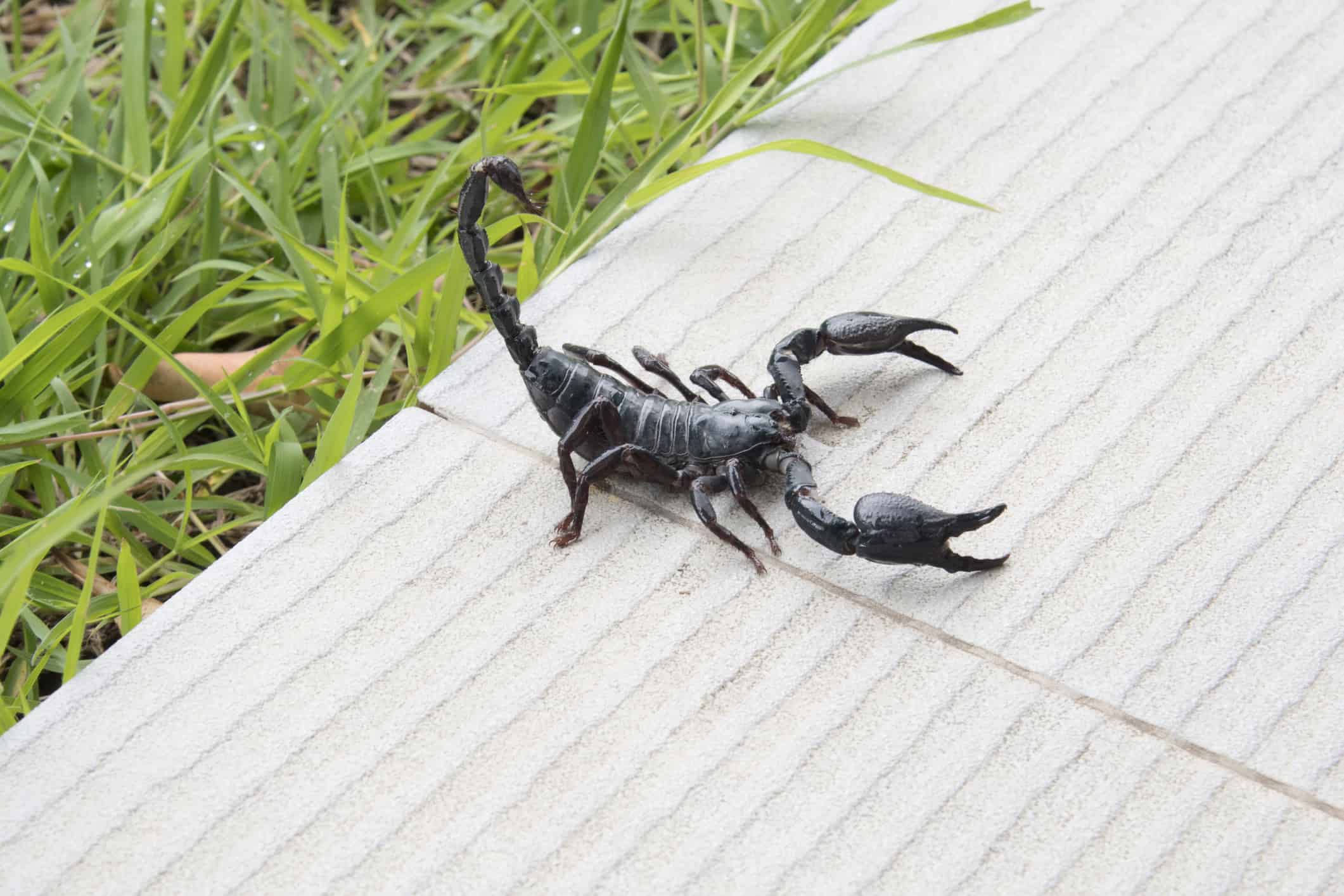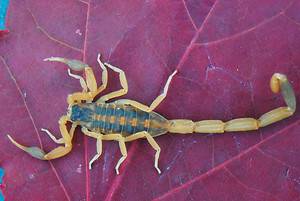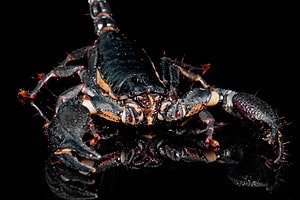Scorpions — native creatures to deserts, rainforests, and grasslands across the world — have an interesting relationship with water. This arachnid, not unlike its spider and mite cousins, doesn’t use its eight legs to propel it through water, but it can survive being completely submerged for at least 48 hours.
Wondering if scorpions can swim now that you know they won’t immediately drown in water? Keep reading to discover 10 interesting facts about scorpions, if they can swim, and how they handle water.
Can Scorpions Swim?

Scorpions use their book lungs to survive underwater.
©Xbuzzi, CC BY-SA 4.0 <https://creativecommons.org/licenses/by-sa/4.0>, via Wikimedia Commons – Original / License
No, scorpions cannot swim. That doesn’t mean that they will die immediately in water, though. As mentioned above, scorpions may live as long as two days underwater without breathing.
Scorpions don’t have limbs designed for propulsion in the water. They can, however, crawl on the sides of a pool or into a pool filter. More often than not, a scorpion has found its way into a home’s pool because it tracked its prey there.
For the vast majority of instances, scorpions don’t make their homes in areas within or immediately touching water sources. Instead, they prefer to live in dark, cool burrows that can regulate their temperature on hot or cold days.
Just because scorpions don’t naturally swim doesn’t mean they’re never in water like pools, lakes, ponds, and streams. If you share an environment with scorpion populations, take extra care in swimming — you may interrupt the scorpion during their meal!
10 Surprising Facts About How Scorpions Handle Water

Did you know that some scorpion species can go without food for months as long as they have water?
©reptiles4all/Shutterstock.com
Now that we’ve learned scorpions can’t swim but can survive underwater, let’s look at some other interesting facts about scorpions and water.
1. They Breathe Through Their Exoskeleton
Like their close arachnid cousin the spider, scorpions don’t use traditional lungs to breathe. What scorpions have are book lungs, or a breathing organ for land-dwellers similar to gills that enable scorpions to “hold” their breath for an elongated period.
Scorpions have not one, not two, but four pairs of book lungs in their abdomen that trap air the scorpion will use to breathe. This reserve of breathable air provides scorpions with days of life. Some species can hold their breath for two days, while others may have enough space in their book lungs to exist without air intake for a whopping six days.
2. The Water Scorpion Is Not a Real Scorpion
Despite having the word “scorpion” in its name, the water scorpion is a freshwater insect with pincer legs and a nasty bite (for tadpoles and small fish).
These underwater predators look slightly similar to scorpions, but they don’t have the tell-tale metasoma with a stinger and venom glands. Instead, the water scorpion captures and kills its prey through biting and grabbing.
While the water scorpion has a tail-like structure, it’s used for breathing. This tail gave scientists the idea to name it after a scorpion.
3. Scorpions Need Fresh Water, Not Pool Water
Just because you have a pool and live in the same vicinity as scorpions doesn’t mean you’ll attract the arachnid to your backyard. Scorpions need fresh water, not the chlorinated water. If they end up somewhere around (or in) your pool, they probably got there accidentally. The most probable answer as to why there’s a scorpion in your pool is that it followed a wasp, snail, small lizard, or spider into your pool to hunt it and then got stuck.
4. Scorpions Can Survive In Pool Filters and Plumbing

Scorpions can survive in your plumbing.
©Damiao Paz/iStock via Getty Images
Residents of Arizona, Nevada, Mexico, Texas, and California should not flush a scorpion they find down the toilet — nor should they push it into a pool’s filter.
As established, some scorpions can hold their breath between two and six days. When you flush a scorpion, it will stay alive in your plumbing. The last thing you want to see at midnight during a late-night bathroom run is a scorpion crawling out of your toilet bowl.
Similarly, consult an expert if you find one (or a few) scorpions in your pool filter. While they may drown if they sit in the container for several days, chances are that they’re still alive when you find them. If they’re alive, they’re able to sting, so leave eradication to the professionals.
5. Some Scorpions Conserve Water for Themselves
The desert scorpion, along with other species, has to adapt to their harsh habitats by finding a way to get water when they need it. The small size of the scorpion and the vastness of deserts make readily available water difficult to find, so the scorpion’s body has a solution.
Research conducted by Neil Hadley suggests that desert scorpions have water loss rates approaching 0.01% of their body weight per hour which “are the lowest reported for desert animals and are especially significant in view of their high surface area-volume ratio.”
When it comes to drinking water, scorpions often replenish their lost hydration through their prey — they suck the body fluids from them unless bulk water is available. Hadley’s research also remarks that “No scorpion species has demonstrated water uptake from either a near-saturated atmosphere or a moist substrate, regardless of its hydration state.”
6. Pet Scorpions Need Humidity
When keeping a scorpion as a pet, owners need to simulate their preferred habitat. For most scorpion species, that means 60% to 80% humidity and routine misting within the tank.
Thanks to evolution, scorpions take in moisture from the air and other parts of their environment. In the wild, this might mean absorbing water from the morning dew that settles over the rainforest or grasslands. In captivity, scorpions need high humidity to maintain their body’s functionality.
7. Scorpions Can Survive for a Year or More Without Food As Long as They Have Water

Species like the desert scorpion can forgo food for up to a year as long as they have access to water.
©K Hanley CHDPhoto/Shutterstock.com
According to the San Diego Zoo, desert scorpions can exist for as long as a year without a meal as long as they have access to water. While most scorpions get water (or some sort of moisture/fluid) out of prey, living without a meal for a year means the scorpion must find another way to stay hydrated.
In grasslands and rainforests, water is abundant enough to allow for a meal-free couple of weeks or months. In the desert, however, scorpions must use all their evolved features, like water conservation and processing of concatenated dew, to keep themselves away from the brink of dehydration.
8. Pet Scorpions Can Get Dehydrated
Did you know that scorpions can get dehydrated? It might surprise you, especially because scorpions can survive as long as a year without food. However, pet scorpions will need access to fresh water or they will dry up. Dehydration affects their molting process as well. Signs of dehydration in your pet scorpion include lethargic behavior and a shriveled appearance.
Your scorpion won’t drink water like a “normal” pet. Some scorpions will scoop water into their mouths with their claws while others will use the insects you give them to stay hydrated. Water use depends largely on scorpion species, of which 2,000 exist.
9. Ice Won’t Affect Scorpions How You Think
Scorpions prefer hot climates. After all, they’re native to almost every continent on earth except Antarctica. However, some species can endure freezing temperatures for a few hours at least and then thaw back out like the temperature change was nothing. One such species: the striped bark scorpion (Centruroides vittatus). In a study conducted by experts Donald H. Whitmore, Roberto Gonzalez, and John G. Baust, the scorpions underwent high subzero temperatures and recovered after the freeze thawed out.
Thank you for reading! Have some feedback for us? Contact the AZ Animals editorial team.








